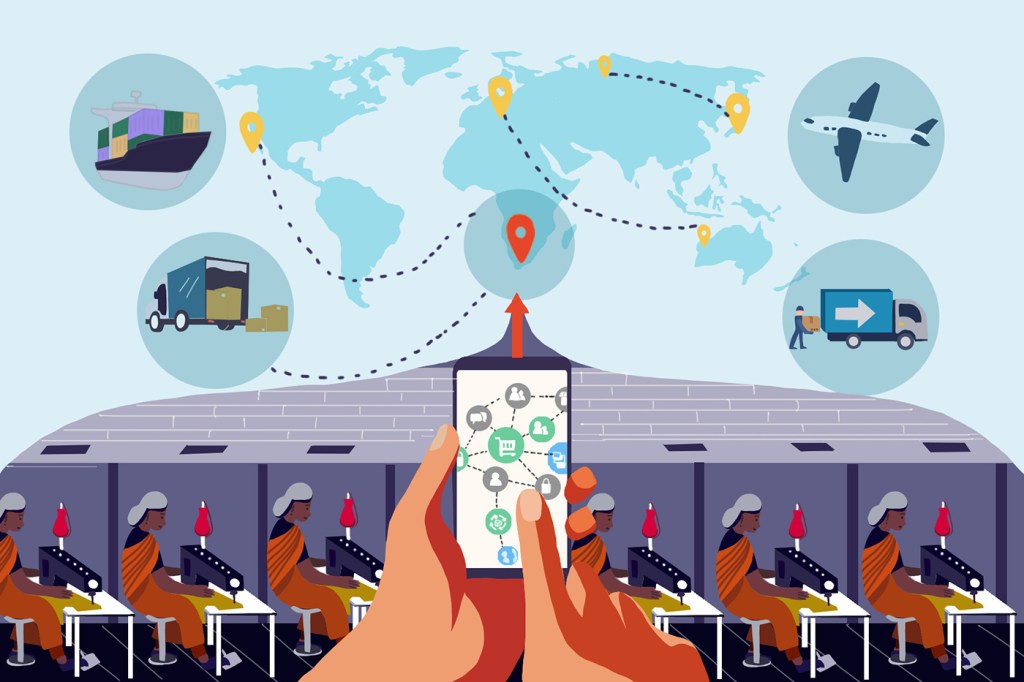Published on
Forced labor in the clothing industry is rampant and hidden. This AI-powered search platform can expose it.
Developed by Northeastern University researchers, Supply Trace combines machine learning and on-the-ground investigation to track goods from apparel companies to regions with a high risk of forced labor.

Almost all of the clothing sold in America comes from overseas, making a long journey on a shipping container into a domestic port. Peer inside any apparel shipment bound for customs checkpoints, groaning with t-shirts or leggings or underwear, and you’ll probably see tags hinting at their origins: Made in Vietnam, China, Indonesia. If you think about it any further, you may suppose that they took a straightforward journey from a factory in that country, eventually reaching the shelves of a store or e-retail warehouse and going into a shopping basket.
It’s more complicated than that. In fact, there’s a very good chance even the company selling those t-shirts and leggings doesn’t have all the information about where they really came from.
That mystery is emblematic of what has long been a frustratingly obscure, dangerous corner of the economy, plagued by human rights violations. The global apparel industry is worth about $1.7 trillion annually. According to watchdog groups, an estimated $161 billion worth of apparel and textile goods are at risk of being produced with forced labor — what human rights activists equate to modern-day slavery. An estimated 27 million people — the population of Australia — are trapped in forced labor across the globe.
And unwieldy journeys from manufacturing regions to consumers in countries that buy their goods make it easy for unscrupulous governments and factories to cover their tracks. “There’s no way for people to know where their products come from,” says Shawn Bhimani, an assistant professor of supply chain management at Northeastern University.
Bhimani and his colleagues are about to change that.
On Thursday, Bhimani and project director Katie Shaw launched Supply Trace [supplytrace.org], an open-access platform that combines machine learning with on-the-ground research to sniff out risks of forced labor in the global apparel supply chain. Meant primarily for industry use, the searchable database allows users to chart the path of apparel goods around the world, connecting hundreds of millions of data points on imports in purchasing countries with in-person reports detailing the locations and practices of facilities that use forced labor.
There’s no way for people to know where their products come from. We’re trying to create a level of transparency that should have always existed.
Shawn Bhimani, Northeastern University assistant professor of supply chain management
Users who search for a specific company on the platform will call up an auto-generated world map with color-coded lines indicating the likelihood that its goods have ties to areas of the world known to use forced labor, along with supporting documents compiled by the project’s facility investigation team at Sheffield Hallam University in the United Kingdom. In its pilot iteration, the target users are professionals within and around the apparel industry: fashion companies, human rights nonprofits and policymakers.
“We’re trying to create a level of transparency that should have always existed,” Bhimani says.
Initially, Supply Trace will be focused on cotton tracked back to the Uyghur region in Western China, a hotbed of forced labor thanks to oppressive government policies against the vulnerable Uyghur ethnic minority in that region. The Sheffield Hallam research team includes Uyghur nationals, some of whom work anonymously to protect their sources and families. But supply chain experts think the model will be a broad-based game-changer, shining a light on how goods of every stripe are sourced across the global supply chain.
“This has the potential to turn into something huge,” says Nada Sanders, a distinguished professor of supply chain management at Northeastern’s D’Amore McKim School of Business. “I would like this to grow across industries and regions.”
What we don’t know
One of the more surprising things about Supply Trace is that the information the platform can uncover was all but impossible to get previously. Under United Nations guidance, “forced labor” entails work compelled under threat of physical violence, fraud, withholding information or extortion of loved ones for another’s financial benefit. Importing goods made with forced labor has been illegal in the United States since 1930; for nearly a century, many Western countries have gradually adopted more specific regulations, banning imports from certain regions and levying fines on companies found to be out of compliance. In 2021, the U.S. Congress passed the Uyghur Forced Labor Prevention Act, banning imports from the region in Western China.
Yet at the same time regulations are addressing forced labor more directly, market pressures are making the problem worse. “Fast fashion” — the business model of producing garments in bulk as cheaply as possible, exemplified by discount retailers like Shein and Temu — has exploded in recent years, ramping up demand for supercheap apparel churned out at a breakneck pace.
“I’m not trying to pick on anybody, but if you think about it realistically, how is it possible to get a shirt or a pair of jeans to a customer so quickly for a few dollars?” Sanders asks. “Someone is not getting paid along the way.”
NGN Magazine, in your inbox.
Sign up to receive thoughtful stories that chronicle innovations and examine inspiring solutions to global problems.
